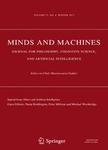版权所有:内蒙古大学图书馆 技术提供:维普资讯• 智图
内蒙古自治区呼和浩特市赛罕区大学西街235号 邮编: 010021

作者机构:Univ Massachusetts Dept Philosophy 100 Morrissey Blvd Boston MA 02125 USA
出 版 物:《MINDS AND MACHINES》 (脑与计算机)
年 卷 期:2016年第26卷第4期
页 面:441-466页
核心收录:
学科分类:08[工学] 0812[工学-计算机科学与技术(可授工学、理学学位)]
主 题:Affordances Social perception Agency AI and Robotics Other minds Embodied cognition
摘 要:How do we perceive the agency of others? Do the same rules apply when interacting with others who are radically different from ourselves, like other species or robots? We typically perceive other people and animals through their embodied behavior, as they dynamically engage various aspects of their affordance field. In second personal perception we also perceive social or interactional affordances of others. I discuss various aspects of perceptible agency, which might begin to give us some tools to understand interactions also with agents truly other than ourselves or ``perhaps agents like present and future social robots. Robots have various kinds of physical and behavioral presence and thus make their agency-if we want to call it that-perceptible in ways that computers and other forms of AI do not. The largely dualist assumptions pertaining to the hidden bodies of traditional Turing tests are discussed, as well as the social affordance effects of such indirect interactions as opposed to interactions in physically shared space. The question is what role various abilities to reveal, hide and dynamically control the body and broader behavior plays in heterogeneous tech or machine mediated interactions. I argue that the specifics and richness of perceptible agency matters to the kind of reciprocity we can obtain.